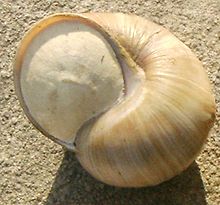Adaptation
Land snails have developed an extraordinary number of adaptations since their evolution and Euchemotrema fasciatum is no exception. There has been fairly little research done specifically into the adaptations of the Mountain Pillsnail; however, it shares many of the characteristics of its brethren Polygyrids.
Shell - The shell is one of the most important adaptations for the Mountain Pillsnail. It is used to ward off predators as well as protect the snail during estivation (Hess, 1974). The shell of a land snail is equipped with teeth and lamella barriers which are used to prevent predators from coming into the shell in order to feed on the snail (Dourson, 2010). The shell, as well as the lamella and teeth, are secreted by the mantle, which can also do repairs should the shell become damaged (Hess, 1974). The columella muscle attaches the snail to its shell and allows it to pull its body up into safety whenever a threat is presented (Hess, 1974). It is the columella muscle around which the shell forms, giving snail shells their trademark whorls (Dourson et al, 2006). The Mountain Pillsnail also has the interesting adaptation of hairs that are found on the whorls of the shell and these have been observed to pick up forest debris which is used as a form of camouflage (Dourson, 2010).

Estivation - Euchemotrema fasciatum, as well as many land snails, have an environmental adaption known as estivation, in which the snail pulls itself up into its shell for a long period of time in order to retain moisture and wait out unfavorable or extreme weather conditions (Hess, 1974). Estivation will be used by land snails during hot and dry summer months, a state in which the snail can remain for extended periods of time, up to years in many cases. During estivation a land snail will secrete an epiphragm using its mantle, over the opening to the shell, which will then harden and create a closed environment (Dourson, 2010). The epiphragm will remain intact until the humidity in the environment increases enough that the snail can break through the epiphragm (Dourson, 2010).
Click here to proceed to our Nutrition page.
This page created by Aaron Young.